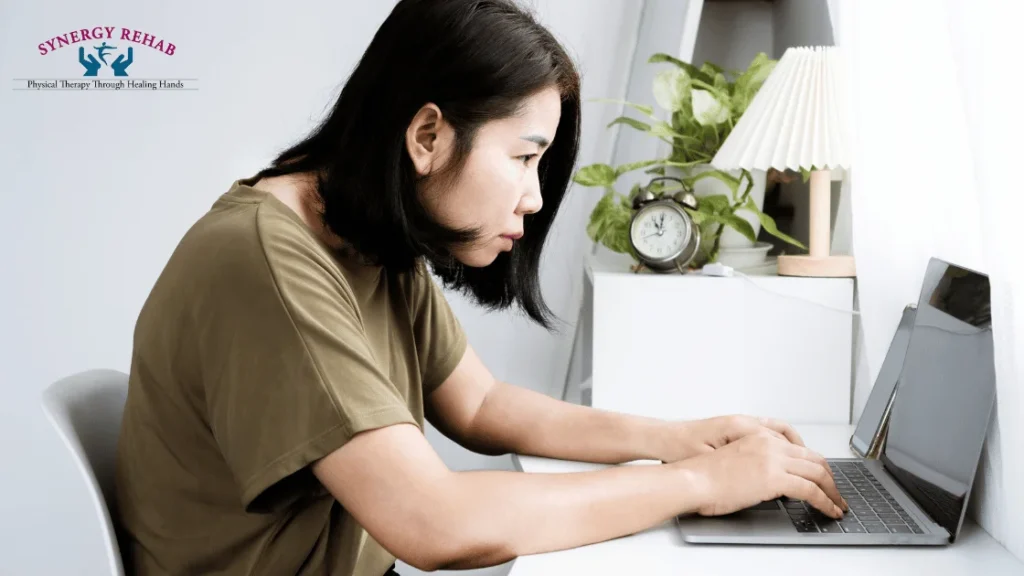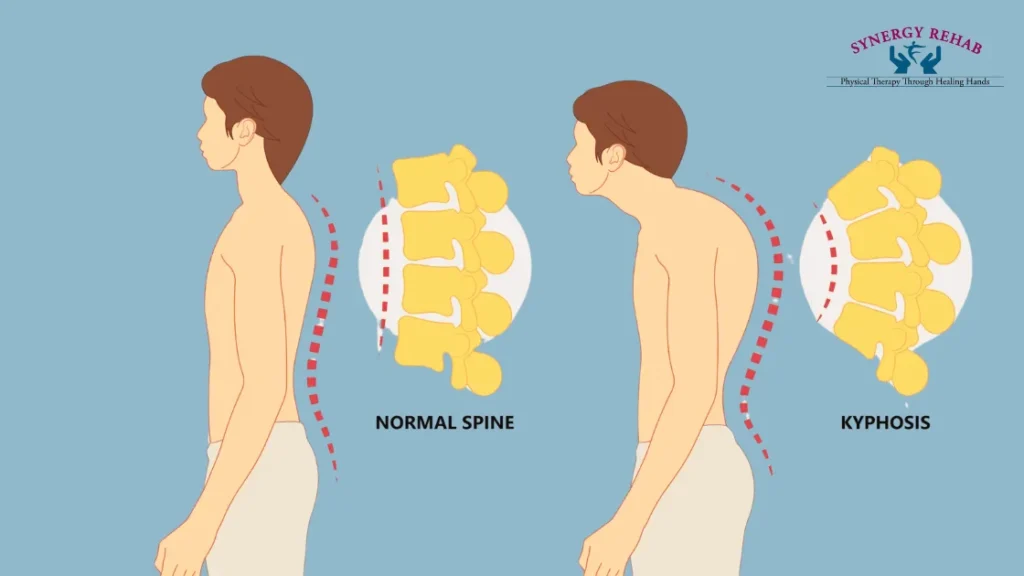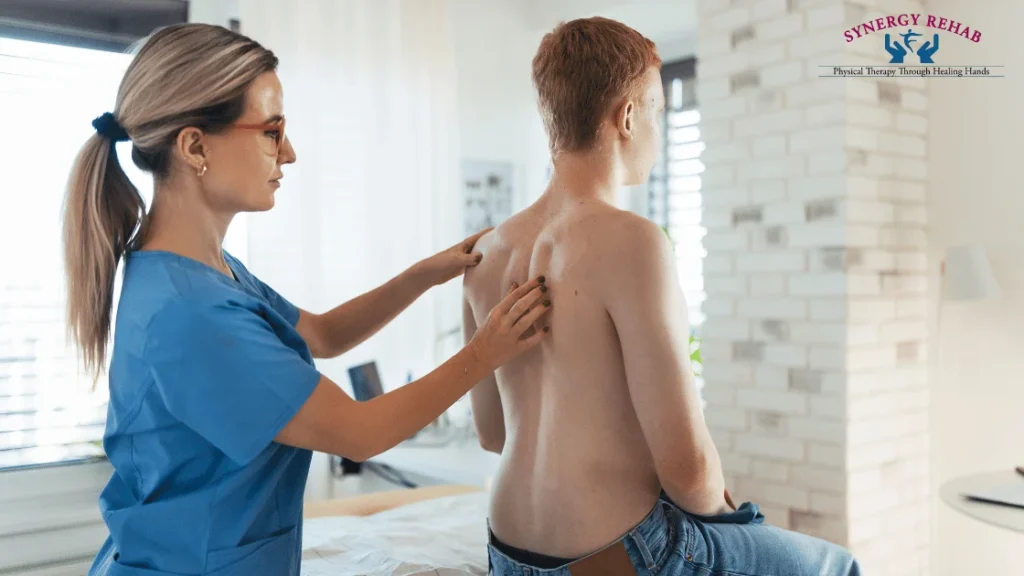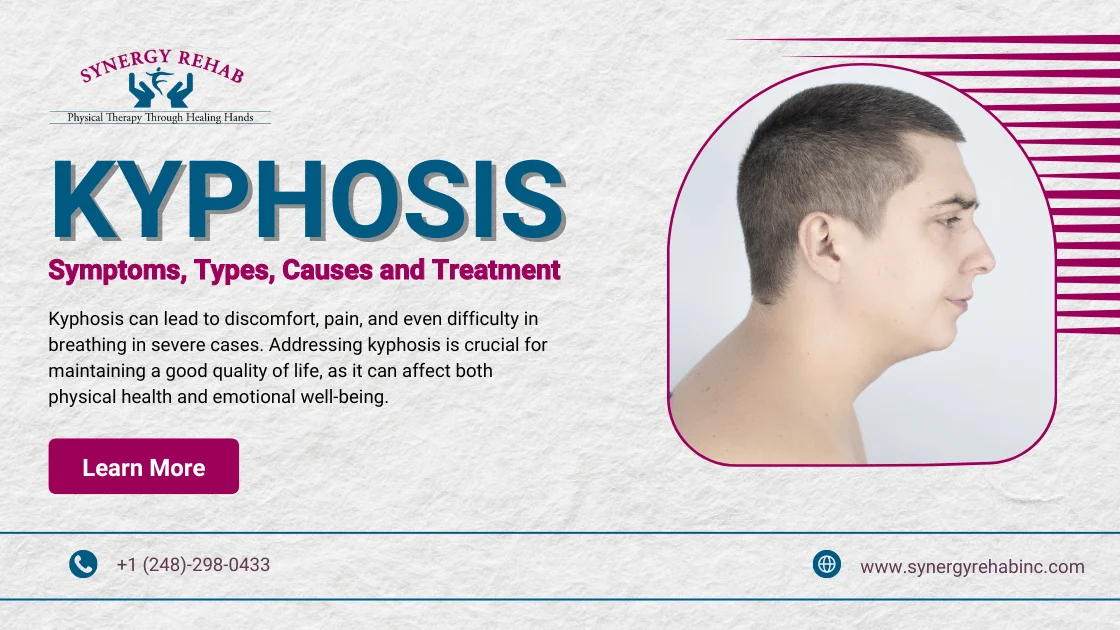Kyphosis (pronounced: kye-Foh-sis), commonly known as a “Rounded upper back” or “Hunchback,” is a condition characterized by an excessive outward curvature of the spine. This condition can lead to discomfort, pain, and even difficulty in breathing in severe cases. Addressing kyphosis is crucial for maintaining a good quality of life, as it can affect both physical health and emotional well-being.
Physical therapy is one of the best Kyphosis treatment options, and it provides relief to many. Only extremely severe conditions may need surgical intervention.
Let us understand the condition, its symptoms, causes and treatment in detail.
What Are the Signs & Symptoms of Kyphosis?
The main signs & symptoms of kyphosis are:
- Rounded & Hunched Back: The most noticeable sign is an abnormal upper spine curvature, making the back appear hunched.
- Breathing Difficulties: In severe cases, the curvature can compress the lungs, leading to breathing issues.
- Back Pain: Persistent or intermittent pain in the back, often worsening with activity.
Early Detection and Diagnosis
Early detection of kyphosis is essential for effective treatment. Regular check-ups and awareness of these signs can help diagnose kyphosis early. If you notice any of these symptoms, it is important to consult a healthcare provider or Tapan Raut, the best physical therapist in Southfield, MI, for a thorough evaluation and appropriate treatment plan.
What Are the Types of Kyphosis?
- Postural Kyphosis: This is usually caused by poor posture, such as slouching or hunching over for long periods. Common in teenagers and young adults, this type features a smooth, flexible curvature that can often be corrected with improved posture and exercises. Symptoms include mild back pain and a noticeable curvature that corrects when lying down.
Treatment involves posture correction, stretching, strengthening exercises, and physical therapy. - Scheuermann’s Kyphosis: This developmental disorder occurs when the vertebrae grow unevenly, leading to a wedge shape. Typically developing during adolescence, this type has a rigid, angular curve. Symptoms include severe back pain, a prominent hump, and reduced flexibility.
Treatment may include physical therapy, back braces, and, in severe cases, surgery to correct the spine. - Congenital Kyphosis: Present at birth due to abnormal spinal development during fetal growth; this progressive curvature worsens as the child grows, often leading to severe deformities. Symptoms are noticeable early in life and worsen over time.
What are the Causes of Kyphosis?

- Poor Posture: Poor posture, such as slouching, hunching over desks, and prolonged use of electronic devices, is a common cause of kyphosis, especially postural kyphosis. This type is often seen in teenagers and young adults and results from habits that lead to an abnormal curvature of the spine.
- Degenerative Diseases: Age-related degenerative diseases, such as arthritis and degenerative disc disease, cause the deterioration of spinal discs and joints. Osteoporosis, which weakens the bones, can cause vertebrae to collapse, leading to abnormal spine curvature and kyphosis, particularly in older adults.
- Spinal Fractures: Trauma to the spine, including fractures from accidents or injuries, can result in kyphosis. When multiple vertebrae are damaged, the spine may heal with an abnormal curvature. Osteoporotic fractures are especially common in older adults and contribute significantly to the development of kyphosis.
- Congenital Factors: Congenital kyphosis occurs due to malformations in the spine that develop before birth. These abnormalities in vertebral formation can lead to progressive curvature as the child grows. This type of kyphosis often requires surgical intervention to correct the spine and prevent further complications.
- Other Medical Conditions: Several medical conditions can also lead to kyphosis. Spinal infections, such as tuberculosis, can damage vertebrae and cause curvature. Neuromuscular conditions, like muscular dystrophy, weaken the spinal muscles, leading to abnormal spine curvature.
Additionally, nutritional deficiencies, particularly a lack of Vitamin D, can weaken bones and contribute to kyphosis.
How is Kyphosis Diagnosed?
- Physical Examination: The physician will check the patient’s posture and spinal alignment. The patient may be asked to bend forward and sideways to assess the spine’s flexibility and curvature.

- X-rays and MRI: X-rays are the primary tool for diagnosing kyphosis, providing detailed images to measure spinal curvature and identify abnormalities. If more detailed information is needed, an MRI scan may be needed to examine the spinal cord thoroughly, as well as the nerves or soft tissues.
How is Kyphosis Treated?
There are two major ways to treat kyphosis:
- Physical Therapy: Customized stretches and workouts help reduce discomfort, strengthen back muscles, and enhance posture. When treating mild to severe kyphosis, physical therapy is frequently the primary course of action for back pain treatment.
- Bracing: Wearing a back brace can help children and adolescents with Scheuermann’s kyphosis avoid developing additional curvature as they grow. Usually, bracing is advised for people whose bones are still growing.
Can Kyphosis Turn Into Scoliosis?
No. Your spine can be affected by both scoliosis and kyphosis. Although they might occur simultaneously, one does not trigger the other. The abnormal spine bending from front to back is known as kyphosis. The abnormal curvature of the spine, either horizontally or from left to right, is known as scoliosis.
Why Doctors Recommend Physical Therapy for Kyphosis Treatment
Physical therapy is a highly effective and non-invasive treatment option for kyphosis. Here are several reasons why it is a preferred choice:
- Improves Posture: Physical therapy focuses on correcting poor posture, a common cause of postural kyphosis. Through targeted exercises and stretches, physical therapists help patients develop better posture habits, which can significantly reduce spinal curvature.
- Reduces Pain: Therapeutic exercises and manual therapy techniques used in physical therapy can effectively relieve back pain and muscle tension associated with kyphosis. This leads to an improved quality of life and better overall function.
- Customized Treatment Plans: Physical therapists create individualized treatment plans tailored to each patient’s specific needs and conditions. This personalized approach ensures that the exercises and therapies are suitable and effective for the patient’s particular type of kyphosis and overall health.
Visit Synergy Rehab Physical Therapy for Kyphosis Treatment

If you’re struggling with kyphosis, Synergy Rehab offers comprehensive kyphosis treatment options to help you manage and improve your condition. Our expert team provides personalized care, utilizing the latest back pain physical therapy techniques to address your specific needs. Take the first step towards better spinal health and improved quality of life.
Book a consultation with Synergy Rehab today and start your journey to a healthier spine.



